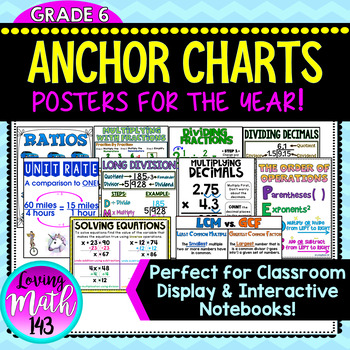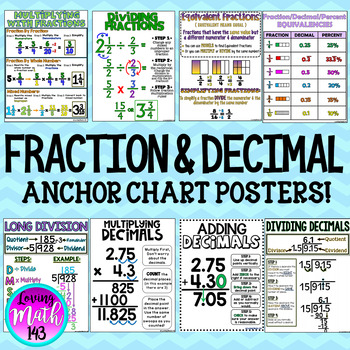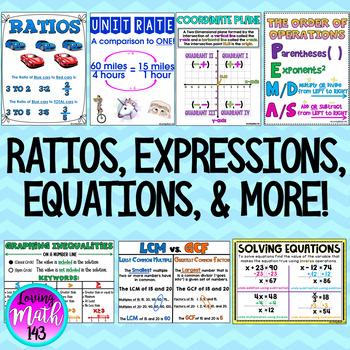6th Grade Math Anchor Posters for the whole Year! {BUNDLE!}
- Zip
Products in this Bundle (44)
showing 1-5 of 44 products
Bonus
Description
This Bundle of sixth grade math reference sheets are designed and aligned with 6th grade math! Fractions, Decimals, Ratios, Proportions, Expressions, Equations, Combining like terms, and more! Pretty much everything students need to know and understand for 6th grade. They make for excellent scaffolds and tools for support. Especially during distance learning.
Each anchor chart makes for an excellent tool to display in your classroom or handout to students to put in their interactive math notebook or binder. These anchor charts will last work throughout the 6th grade school year! I love to color-coordinate my anchor charts so they are easy to follow and understand!
***********************************************************************************************
HOW TO USE:
Anchor charts can be printed on a regular 8.5 x 11 printing paper and placed in student notebooks, or printed as a half-page making an excellent resource for students interactive notebook.
You can also scale the PDF file and print it on poster size paper and display it within your classroom. That is how I use my anchor charts.
POSTERS INCLUDED:
The Number System:
- Adding Decimals
- Multiplying Decimals
- Dividing Decimals
- Reading Decimals
- Long Division Steps + Example
- Divisibility Rules
- Equivalent Fractions
- Converting Mixed Number to Improper Fraction
- Multiplying Fractions & Mixed Numbers
- Dividing Fractions & Mixed Numbers
- Fraction / Decimal / Percent Equivalencies
- Least Common Multiple (LCM) vs. Greatest Common Factor (GCF)
- Ordering Positive/Negative on a Number Line
- Vertical Number Line (Positive & Negative)
- Reflecting on the Coordinate Plane
- The Coordinate Plane (4 Quadrants)
- Absolute Value
Ratios & Proportions:
- Ratios
- Ratio Tables
- Unit Rate
- Constant of Proportionality
- Units of Measurement (weight, length, capacity)
- Liquid Conversions: Gallon / Quart / Pint / Cup
- Percent Proportions: Part/Whole = Percent/100
Expressions & Equations:
- Combine Like Terms
- Algebra Vocabulary (variable, constant, expression, coefficient)
- Order of Operations
- Powers & Exponents
- One-step Equations
- Mathematical Properties (Commutative/Associative/Distributive/Identity)
- Writing & Graphing Inequalities
- The Distributive Property
Geometry
- Area of Parallelogram, Triangle, Trapezoid, Square
- Area of Composite Figures
- Surface Area: Rectangular Prism
- Volume of a Rectangular Prism
Probability & Statistics:
- Mean, Median, Mode, Range
Classroom Display:
- 6th Grade Common Core Standards "I can Statements"
- Class Assessment Emojis
- "CUBES" acronym - Breaking down word problems
- Math Alphabet (Grades 3-6)
- Math Keywords (x/+/-)
- Multiplication Facts Bubble Letters
- 6th Grade Math Reference Sheet - Study Guide
- Accountable Talk - Math prompts
- Math Alphabet (Upper Elementary)
- Math Problem Solving Strategies
***********************************************************************************************
LICENSING TERMS: This purchase includes a license for one teacher only for personal use in their classroom. Licenses are non-transferable, meaning they can not be passed from one teacher to another. No part of this resource is to be shared with colleagues or used by an entire grade level, school, or district without purchasing the proper number of licenses.
COPYRIGHT TERMS: This resource may not be uploaded to the internet in any form, including classroom/personal websites or network drives, unless the site is password protected and can only be accessed by students.





